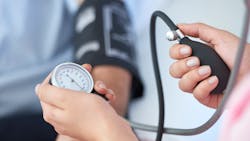Chronic disease management and care coordination: Expanding the dental provider’s role
As of 2018, approximately one-half of adult patients in the United States have at least one of 10 common chronic diseases.1 The COVID-19 pandemic has proven that more patients have multiple chronic conditions and require infection-related treatment, while at the same time fewer patients are seeking preventive care.2 Subsequently, it is estimated there will be a shortage of up to 35,600 primary care providers by 2025.1
Considering that dental practitioners are formally educated in the biomedical sciences, and that approximately 9% of patients visit a dentist but not a physician,1 dental providers are well positioned to examine the role that chronic diseases play in oral health outcomes and could be the answer to addressing these issues.3 Currently, the responsibilities of a dental hygienist include a wide array of preventive and treatment protocols; however, with career developments and the evolution of dentistry, we need to pose these questions: Could dental hygienists broaden their role in dentistry? How can we expand our responsibilities to be the direct liaison in chronic disease management?
All-inclusive medical history
As dental providers, we know the importance of a patient’s medical history, but to what extent is it important when it comes to clinical delivery of dental care? Essentially, medical history is a framework for providing care and treatment.4 Information regarding systemic conditions can impact dental health as well as systemic health, and vice versa.4 Likewise, it is important to educate our patients about the direct correlation between oral and systemic health, so that they understand the importance of their medical history review during the dental visit.5
Given that there are a number of systemic correlations, the dental hygienist can empower patients to take control of their health and manage their systemic disease.6 As health-care professionals, we can take the medical history review a step further and implement what we are trained to do—i.e., go beyond the scope of delivering therapeutic care and assess the patient beyond their oral health status. Conditions such as cardiovascular disease, obesity, and sleep apnea coincide and can affect dental health. Hygienists can also screen for other diseases and conditions, and, in fact, the ADA suggests it is well within dentistry’s scope of practice to administer screenings and tests to patients for chronic diseases and conditions.7
Hypertension, sleep apnea, and obesity
“Nearly half a million deaths in the United States included hypertension as a primary or contributing cause.”8 As licensed hygienists, it is standard of care to assess and record blood pressure, as this step could help patients take control of their overall health.9 Dental patients who are not being treated by their primary care physician for disease will typically view themselves as being “healthy,” yet these same patients typically see their dental hygienist two to four times per year for routine preventive care.9
One way to bring awareness of health-related issues to our patients is to measure and record vital signs, including blood pressure, at each recall appointment.3 Screening for hypertension during routine preventive dental appointments is imperative, because elevated blood pressure is often indicative of other serious medical conditions.9 Blood pressure readings are also helpful when choosing the appropriate local anesthetic for dental injections.9
Dental providers understand the importance of these assessments and measures, but how many of us are doing them? As health-care providers, it is our responsibility to provide the highest level of care and discuss our findings with our patients. We need to take prehypertension or hypertension status into account when delivering dental care. Our knowledge and understanding of this condition and its correlation with other chronic conditions can help patients improve their total health.
Sleep apnea—of which roughly 80% of cases are undiagnosed—is another chronic condition that is a significant health issue.10 When left untreated, sleep apnea can lead to high blood pressure, chronic heart disease, and stroke, and associations can also be linked to diabetes and depression.10 In 2017, the American Dental Association (ADA) created a policy statement that addressed the dental provider’s role in assessing patients’ risk for sleep-related breathing disorders, referring patients accordingly, and evaluating them for oral appliance therapy (OAT).11
As part of prevention protocols, dental hygienists can play a key role in assessing a patient’s airway to include an obstructive sleep apnea (OSA) risk assessment during preventive appointments. As an integrated part of a multidisciplinary care team, the hygienist can assist in providing long-term care for patients with OSA. If needed, an OSA oral appliance can be fabricated and used by the patient to aid in OSA-related disorders.11
As dental hygienists and prevention experts, we have been trained to provide nutritional counseling to patients under our care. While it is important to offer counseling to patients who have a high rate of dental caries, it is just as important to counsel patients for the purposes of reducing risk factors associated with a multitude of chronic diseases.12
According to the Centers for Disease Control and Prevention (CDC), approximately 65% of US adults suffer from weight problems.12 While addressing these issues may be a sensitive topic, one way for a dental provider to implement nutritional counseling into practice is to start with updating the medical history to include questions regarding weight in association with sleep.12 A decrease of just 10% body weight can lead to significant clinical improvement in OSA, which proves the importance of addressing weight when trying to manage OSA or sleep-related breathing disorders.12 Additionally, if a blood pressure reading is taken and recorded as elevated, the patient can be made aware of the associations between diet, hypertension, and sleep issues.
HbA1c, salivary sampling, and COVID-19 vaccinations
One of the most common systemic diseases discussed in the dental setting is diabetes and its link to periodontal disease. In fact, we know that patients diagnosed with periodontal disease may have difficulty controlling their blood sugar, and patients with diabetes are at a higher risk for periodontal disease. A joint effort between dental and medical providers to manage patients with these conditions is necessary.
Beyond oral treatment, a dental provider could extend their role by performing blood tests on patients who present with periodontal conditions and who have an existing diabetes diagnosis. A recent study was conducted in a Research Network of Dental Clinics coordinated by the Spanish Society of Periodontology (SEPA) involving a diabetes risk screening questionnaire, periodontal assessment, and performance of an HbA1c blood test during the dental appointment.13 Results showed approximately 8% of patients had undiagnosed diabetes or prediabetes, demonstrating that dental providers can play a key role in the early detection of diabetes mellitus and arrange referral for confirmation and treatment.13
As part of routine clinical examination, the hygienist completes an oral cancer screening using visual examination and palpation of the tissues to check for abnormalities. Typically, a biopsy is recommended when lesions are suspicious.14 While there are new and emerging artificial intelligence (AI) technologies that can assist with the visual examination of lesions, saliva collection is proving to be a quick and easy way to diagnose several types of cancer, including oral cancer. At this time, testing saliva can confirm the presence of HPV and HIV, as salivary markers can be identified showing altered levels of certain mRNA molecules, including the activation of proto-oncogenes and oncogenes, as well as the inactivation of tumor suppressor genes.15 Additionally, saliva samples have been shown to accurately detect SARS-CoV-2 antibodies and are an alternative method for antibody testing within research and in clinical use.16
Clearly, this testing method could be performed by a dental provider, as COVID-19 screening protocols are already being performed in dental settings across the nation. Dentists and dental hygienists ask a series of questions before appointments and perform temperature checks on the day of the patient’s appointment.17 Implementing an additional COVID-19 screening tool in the dental office could lead to further reducing the spread of the virus.7
COVID-19 testing is currently within the scope of practice for dentists when used for screening; however, the dental provider must obtain the requisite licensing, including a CLIA Certificate of Waiver (Clinical Laboratory Improvement Amendments of 1988), before providing screening.18 With proper training, dentists and hygienists can expand COVID-19 screening protocols as part of the course of dental treatment.18
As testing becomes more widely available, dentists can use them to test staff and as a risk assessment of the patient prior to dental treatment. In addition to screening tools, administering vaccinations within the dental setting is on the horizon. In fact, in December 2020, the Oregon Dental Association influenced lawmakers to allow dentists to administer vaccinations beyond the flu shot, making Oregon the first in the nation to have dentists deliver the COVID-19 vaccine.19 As of January 2021, several states have authorized dental hygienists to administer COVID-19 vaccines after completion of education and training.20
Conclusion
Screening for chronic diseases within dentistry can play an important role in a patient’s overall health. In many cases, the dentist or hygienist is the only health-care provider a patient sees on a routine basis. Furthermore, screening for chronic diseases supports population health initiatives and can provide valuable data that both medical and dental professionals might be missing. While there is a cost involved with additional screening tools and licensing measures, these expenses can be offset against profits.18 With the advancements in dentistry and enhanced patient care protocols in place due to the COVID-19 era, it is the dental provider who can assist in chronic disease management and lead the industry to become an integral part of medicine.
References
- Leader D, Vujicic M, Harrison B. Could dentists relieve physician shortages, manage chronic disease? Health Policy Institute Research Brief. American Dental Association. December 2018. Accessed February 26, 2020. https://www.ada.org/~/media/ADA/Science%20and%20Research/HPI/Files/HPIBrief_1218_1.pdf?la=en
- Krist AH, DeVoe JE, Cheng A, Ehrlich T, Jones SM. Redesigning primary care to address the COVID-19 pandemic in the midst of the pandemic. Ann Fam Med. 2020;18(4):349-354. doi:10.1370/afm.2557
- Gambhir RS. Primary care in dentistry – an untapped potential. J Family Med Prim Care. 2015;4(1):13-18. doi:10.4103/2249-4863.152239
- Tekavec C. Medical history: An office’s responsibility. DentistryIQ. February 25, 2008. Accessed December 15, 2020. https://www.dentistryiq.com/practice-management/insurance/article/16363283/medical-history-an-offices-responsibility
- Luhring D. Medical history: Your patient is not telling you everything. Today’s RDH. September 2, 2020. Accessed December 15, 2020. https://www.todaysrdh.com/medical-history-your-patient-is-not-telling-you-everything/
- Ortiz M. The A1C score: The A1C score is well within the dental hygiene scope of practice. RDH. September 28, 2015. Accessed December 15, 2020. https://www.rdhmag.com/patient-care/article/16405168/the-a1c-score-the-a1c-score-is-well-within-the-dental-hygiene-scope-of-practice
- ADA supports point of care COVID-19 testing by dentists. American Dental Association. November 4, 2020. Accessed December 24, 2020. https://www.ada.org/en/press-room/news-releases/2020-archives/november/ada-supports-point-of-care-covid-19-testing-by-dentists
- High blood pressure: Facts about hypertension. National Center for Chronic Disease Prevention and Health Promotion, Division for Heart Disease and Stroke Prevention. Centers for Disease Control and Prevention. Updated September 8, 2020. Accessed January 9, 2021. https://www.cdc.gov/bloodpressure/facts.htm
- Lawson L. 10 reasons why we must take dental patients’ blood pressure. RDH. January 16, 2017. Accessed December 15, 2020. https://www.rdhmag.com/patient-care/article/16409903/10-reasons-why-we-must-take-dental-patients-blood-pressure
- Sleep apnea information for clinicians. American Sleep Apnea Association. Sleepapnea.org. Accessed December 20, 2020. https://www.sleepapnea.org/learn/sleep-apnea-information-clinicians/
- The role of dentistry in the treatment of sleep related breathing disorders. American Dental Association. Accessed January 9, 2021. https://www.ada.org/~/media/ADA/Member%20Center/FIles/The-Role-of-Dentistry-in-Sleep-Related-Breathing-Disorders.pdf?la=en
- Nosti J, Nosti J. The dentist’s role in nutritional counseling. Inside Dentistry. 2016;12(4). Accessed December 27, 2020. https://www.aegisdentalnetwork.com/id/2016/04/the-dentists-role-in-nutritional-counseling
- Montero E, Matesanz P, Nobili A, et al. Screening of undiagnosed hyperglycaemia in the dental setting: the DiabetRisk study. A field trial. J Clin Periodontol. 2021;48(3):378-388. doi:10.1111/jcpe.13408
- Martin J. New saliva test for oral cancer. Dear Doctor—Dentistry & Oral Health. Updated May 1, 2017. Accessed December 5, 2020. https://www.deardoctor.com/articles/new-saliva-test-for-oral-cancer/
- Markopoulos AK, Michailidou EZ, Tzimagiorgis G. Salivary markers for oral cancer detection. Open Dent J. 2010;4:172-178. doi:10.2174/1874210601004010172
- New saliva-based antibody test for SARS-CoV-2 highly accurate in initial study. Johns Hopkins Bloomberg School of Public Health. New release. November 13, 2020. Accessed December 5, 2020. https://www.jhsph.edu/news/news-releases/2020/new-saliva-based-antibody-test-for-sars-cov-2-highly-accurate-in-initial-study.html
- Technological advancements, advocacy needed before point-of-care COVID-19 testing will meet dental office needs. California Dental Association. September 28, 2020. Accessed December 24, 2020. https://www.cda.org/Home/News-and-Events/Newsroom/Article-Details/technological-advancements-advocacy-needed-before-point-of-care-covid-19-testing-will-meet-dental-office-needs
- Croser D. Saliva testing. BDJ in Pract. 2020;33(8):28-29. doi:10.1038/s41404-020-0475-8
- Koumoué C. Historic moment: Oregon dentist first dentist in the US to administer COVID-19 vaccine. KGW8 News. Published December 26, 2020. Updated December 27, 2020. Accessed January 2, 2021. https://www.kgw.com/article/news/health/coronavirus/oregon-is-the-only-state-in-the-nation-where-your-dentist-is-authorized-to-give-you-a-vaccine-other-than-a-flu-shot/283-26f77398-740f-4932-9acd-0e342c79ecaa
- COVID-19 vaccine administration by dental hygienists. American Dental Hygienists’ Association. Revised February 4, 2021. Accessed February 7, 2021. https://www.adha.org/resources-docs/COVID-19_Vaccine_Administration_by_DH.pdf
SHANNON SOMMERS, MSHI, BTDH, RDH, holds a Master of Science in health informatics from the Medical University of South Carolina and is currently a research administrator with Delta Dental of Michigan. With more than 20 years’ experience in dentistry, Sommers aims to use her dental background and informatics skills to promote and advance dental informatics. She can be reached at [email protected].
ALICIA WEBB, MSHI, BTDH, RDH, has been a clinician in dentistry since 2006 and has experience as an educator in a dental hygiene program. As one of the few registered dental hygienists to graduate with a Master of Science in health informatics, she wants to use her informatics knowledge coupled with her dental background to develop and analyze data-driven solutions to improve patient health and outcomes. Webb can be reached at [email protected].
About the Author

Shannon Sommers, MSHI, BTDH, RDH
SHANNON SOMMERS, MSHI, BTDH, RDH, holds a bachelor of technology in dental hygiene from the State University of New York at Canton and a master of science in health informatics from the Medical University of South Carolina. She has more than 20 years of experience in dentistry and has been a dental hygienist since 2006. She strives to use her dental background and informatics skills to influence population health by promoting and advancing the use of dental informatics.

Alicia Webb, MSHI, BTDH, RDH
ALICIA WEBB, MSHI, BTDH, RDH, has been a clinician in dentistry since 2006 and has experience as an educator in a dental hygiene program. As one of the few registered dental hygienists to graduate with a master of science in health informatics, she wants to use her informatics knowledge coupled with her dental background to improve population health by developing and analyzing data-driven solutions to improve the delivery of quality dental care.
